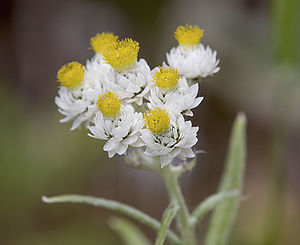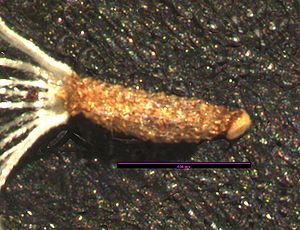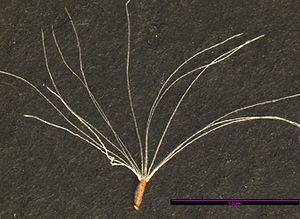Difference between revisions of "Anaphalis margaritacea"
(→Habitat) (Tag: VisualEditor) |
|||
| (52 intermediate revisions by 5 users not shown) | |||
| Line 1: | Line 1: | ||
| − | ''''' | + | * Scientific Name: ''Anaphalis'' ''margaritacea'' |
| − | === | + | * Family: Asteraceae |
| − | Asteraceae | + | * Common Names: pearly everlasting |
| + | * Synonyms/Misapplications: ''Gnaphalium'' ''margaritaceum'' | ||
| + | * Codon: ANAMAR | ||
| + | ---- | ||
| + | [[File:ANMA RodGilbert flw good.jpg |thumb|Photo by Rod Gilbert. Also featured on Main Page]] | ||
| + | === Taxonomy === | ||
| + | {{Taxobox | ||
| + | | image = | ||
| + | | image_caption = Photo by Rod Gilbert. Also featured on Main Page | ||
| + | | name = | ||
| + | | regnum = [[Plant]]ae | ||
| + | | subregnum = Viridiplantae | ||
| + | | phylum = Tracheophyta | ||
| + | | subphylum= Spermatophytina | ||
| + | | classis = Magnoliopsida | ||
| + | | subclassis = Asteranae | ||
| + | | ordo = Asterales | ||
| + | | familia = Asteraceae | ||
| + | | genus = ''Anaphalis'' DC. | ||
| + | | species = '''''Anaphalis margaritacea''''' (L.) Benth. | ||
| + | | subspecies = | ||
| + | | synonyms = *''Anaphalis occidentalis'' (Greene) A. Heller | ||
| + | *''Gnaphalium margaritaceum'' L. | ||
| + | }} | ||
| + | <ref>Integrated Taxonomic Information System. Retrieved from https://www.itis.gov/servlet/SingleRpt/SingleRpt?search_topic=TSN&search_value=36529</ref> | ||
| + | |||
===Plant Description=== | ===Plant Description=== | ||
| − | + | Dioecious, perennial, rhizomatous herb with woolly stems and globular pseudanthia, growing to 90 cm tall. Leaves cauline, alternate, sessile, lanceolate to linear, woolly (mostly below), greenish grey to whitish. Inflorescences are racemous, crowded and often flattened, appearing umbellate. Pseudanthia to 1 cm wide with persistent white bracts. Flowers discoid. Fruits are achenes with stubby projections.<ref name=":1" /><ref>Bowcutt, F., & Hamman, S. (2016). Vascular Plants of the South Sound Prairies. p. 71</ref><ref>[https://ucjeps.berkeley.edu/eflora/eflora_display.php?tid=310 Jepson Herbarium Online Flora]</ref> | |
| − | + | ||
| − | + | ||
| − | + | ||
| − | + | ===Bloom Period=== | |
| + | July through September.<ref name=":1">WTU Herbarium, Burke Museum, & University of | ||
| + | Washington. Retrieved from http://biology.burke.washington.edu/herbarium/imagecollection/taxon.php?Taxon=Anaphalis%20margaritacea</ref> | ||
| + | ===Distribution=== | ||
| + | Widely distributed throughout Washington; occurring throughout North America except for portions of Midwest and Southeast.<ref name=":1" /> | ||
| + | ===Habitat=== | ||
| + | Dry to seasonally moist open areas.<ref name=":1" /> | ||
| + | ===Uses=== | ||
| + | In folk medicine, it is used as a salve for burns. (Strickland)<ref name=":0">Native Plants of North America.” Retrieved from https://www.wildflower.org/plants/result.php?id_plant=anma.</ref> | ||
| + | |||
| + | ===Propagation=== | ||
| + | [[http://www.plant-materials.nrcs.usda.gov/pubs/orpmcmt9920.pdf Propagation protocol from USDA NRCS]] | ||
| + | [[File:Anaphalis margaritacea single.jpg|300px|thumb|''Anaphalis margaritacea'', photo: Lisa Hintz]] | ||
===Seed=== | ===Seed=== | ||
| − | ''' | + | |
| + | [[File:Anaphalis margaritacea with pappus.jpg|300px|thumb||''Anaphalis margaritacea'' with pappus, photo: Lisa Hintz]] | ||
| + | |||
'''Seed sample from '''2010 | '''Seed sample from '''2010 | ||
| Line 37: | Line 73: | ||
'''Longitudinal Cross Section:''' elliptical [[File:ANMA-long-crosssection.png]] | '''Longitudinal Cross Section:''' elliptical [[File:ANMA-long-crosssection.png]] | ||
| − | + | ===Photo Gallery=== | |
| − | + | <gallery> | |
| + | File:ANAMAR2.jpg|Photo: Craig Althen, 2010 | ||
| + | File:ANAMAR3.jpg|Photo: Craig Althen, 2017 | ||
| + | </gallery> | ||
| − | + | === References === | |
| + | <references /> | ||
Latest revision as of 14:25, 24 June 2021
- Scientific Name: Anaphalis margaritacea
- Family: Asteraceae
- Common Names: pearly everlasting
- Synonyms/Misapplications: Gnaphalium margaritaceum
- Codon: ANAMAR
Contents
Taxonomy
| Scientific classification | |
|---|---|
| Kingdom: | Plantae |
| Subkingdom: | Viridiplantae |
| Phylum: | Tracheophyta |
| Subphylum: | Spermatophytina |
| Class: | Magnoliopsida |
| Subclass: | Asteranae |
| Order: | Asterales |
| Family: | Asteraceae |
| Genus: | Anaphalis DC. |
| Species: | Anaphalis margaritacea (L.) Benth. |
| Synonyms | |
| |
Plant Description
Dioecious, perennial, rhizomatous herb with woolly stems and globular pseudanthia, growing to 90 cm tall. Leaves cauline, alternate, sessile, lanceolate to linear, woolly (mostly below), greenish grey to whitish. Inflorescences are racemous, crowded and often flattened, appearing umbellate. Pseudanthia to 1 cm wide with persistent white bracts. Flowers discoid. Fruits are achenes with stubby projections.[2][3][4]
Bloom Period
July through September.[2]
Distribution
Widely distributed throughout Washington; occurring throughout North America except for portions of Midwest and Southeast.[2]
Habitat
Dry to seasonally moist open areas.[2]
Uses
In folk medicine, it is used as a salve for burns. (Strickland)[5]
Propagation
[Propagation protocol from USDA NRCS]
Seed
Seed sample from 2010
Average Measurement: 0.6 x 0.2 x 0.2
Measurement Range: L: 0.4 - 0.75, W: 0.1 - 0.3, D: 0.1 - 0.3
Features
Shape: Seeds somewhat ribbed. Right above hilum, seed narrows considerably before flaring out again.
Color: Seed is brown. Hilum is glossy and puckered, lighter colored that rest of seed.
Additional Features: Pappus of downy white hairs significantly longer that seed itself.
Surface: Seed covered in clear globules and is slightly lustrous.
Could be confused with: Antennaria howellii
Latitudinal Cross Section: elliptical ![]()
Longitudinal Cross Section: elliptical ![]()
Photo Gallery
References
- ↑ Integrated Taxonomic Information System. Retrieved from https://www.itis.gov/servlet/SingleRpt/SingleRpt?search_topic=TSN&search_value=36529
- ↑ 2.0 2.1 2.2 2.3 WTU Herbarium, Burke Museum, & University of Washington. Retrieved from http://biology.burke.washington.edu/herbarium/imagecollection/taxon.php?Taxon=Anaphalis%20margaritacea
- ↑ Bowcutt, F., & Hamman, S. (2016). Vascular Plants of the South Sound Prairies. p. 71
- ↑ Jepson Herbarium Online Flora
- ↑ Native Plants of North America.” Retrieved from https://www.wildflower.org/plants/result.php?id_plant=anma.





